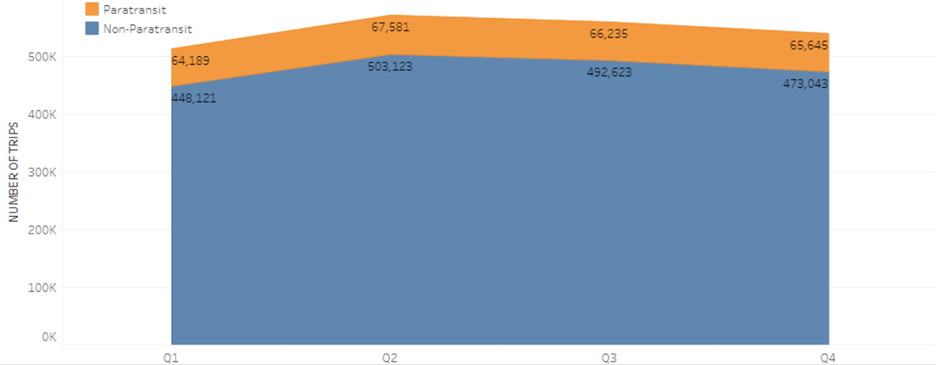Key Takeaway: Taxis are a key component in providing accessible, affordable, same day on-demand service to seniors and individuals with disabilities in San Francisco. This has been accomplished by ensuring accessibility is a component in the development of new taxi policies and programs. It is paramount that SFMTA continue this focus on accessibility as the taxi industry evolves.
Taxis are a critical mode of the San Francisco transportation network. Taxi services provide flexible on-demand door-to-door travel to the general public, an important alternative for when transit, walking, rolling or driving yourself is not an option.
The SFMTA has adopted a number of policies to ensure taxi services are accessible. We are also piloting new programs and policies to improve the customer experience, with a focus on ensuring individuals with disabilities benefit fully. Taxi policies that support accessibility of the program include:
- Mandatory taxi participation in the San Francisco Paratransit Program: All taxis must accept paratransit taxi debit cards, which helps reduce rider reliance on paratransit van service that must be booked at least one day ahead.
- Discount programs: Services like SF Paratransit Taxi and the Essential Trip Card (ETC) taxi program make taxi service even more accessible to eligible riders with low incomes.
- Mobile App Accessibility Requirements: To encourage availability of ramp taxis, all approved taxi app providers must grant access to all ramp taxis, even if a ramp is not part of a fleet that is affiliated with the app.
- Driver and Ramp Driver Training: Ramp drivers must undergo securement training and are required to maintain a valid ramp taxi training certificate.
- Inspector audits to ensure drivers are adhering to accessibility requirements: Taxi investigators conduct video audits to ensure that self-reported general-public ramp trips are properly credited to drivers. Video audits are also conducted to verify that drivers are properly securing passengers. Taxi investigators respond to complaints about ramp driver behavior and work with Accessible Services and the SFMTA's Paratransit broker to ensure drivers are properly trained.
To ensure that the public receives reliable and safe transportation, policies and procedures will continue to be evaluated and updated in response to changes in the industry and challenges that may arise.
Fare Transparency: Taxi Upfront Fare Pilot
In September 2021, the SFMTA Board authorized the creation of the "Taxi Upfront Fare Pilot" program. In September 2023, the SFMTA Board extended the Taxi Upfront Fare Pilot term to June 30, 2025.
The program allows taxi customers to book a ride through a taxi e-hail app and pay the fare both before and after their trip. The program also allows taxi e-hail app providers to dispatch trips that originate with third-party entities (i.e. entities that do not receive permits issued by the SFMTA), which may offer upfront fares that are not based on taximeter rates.
Taxi e-hail app providers are not required to offer paratransit taxi trips as part of the pilot, although they may elect to do so. Furthermore, the pilot does not allow paratransit users to hail taxis through third-party apps.
One of the expressed goals of the pilot is to maintain a consistent level of service for traditional taxi trips, including Paratransit taxi trips. SFMTA staff work with the SF Paratransit broker and the disability community to analyze the impact of the pilot on Paratransit service and costs, including analyzing the relative proportion of paratransit taxi trips to all taxi trips before and during the pilot term.
During the pilot term extension, the SFMTA is also exploring allowing Third-Party Wheelchair Accessible Vehicle (WAV) Trips, requiring collaboration between the SF Paratransit team, third-party entities, taxi companies and the California Public Utilities Commission (CPUC).
Findings:
The proportion of paratransit taxi trips as compared to total taxi trips have remained largely consistent throughout the periods both before and after the start of the Pilot. Staff interprets consistency as an indication that the pilot has not had a significant impact on the level of service provided to paratransit taxi customers during the pilot term thus far.
There has not been a significant impact from the pilot on the level of paratransit taxi service during peak travel hours or other specific times of day.
Staff compared the level of paratransit service provided by this paratransit taxi drivers before they started participating in the pilot to Q2-Q4 during their participation in the pilot. When these drivers began to increase their participation in the pilot during Q2 and Q3, their level of paratransit taxi service increased at the same time; and when their paratransit taxi service decreased in Q4, their participation in the pilot dipped as well. We interpret these data as an indication that the pilot has not affected the service patterns of paratransit taxi drivers negatively, and instead may have even had a slightly positive impact.
Figure 1. Number of Paratransit Taxi Trips compared to Non-Paratransit Taxi Trips Q1 – Q4
Accessible Text for Figure 1.
Figure 2. Comparison of Paratransit Taxi Service Time-of-Day Distribution in 2022 and 2023
Accessible Text for Figure 2.
Figure 3. Change in the Level of Paratransit Taxi Service Among Paratransit-Pilot Drivers
| Drivers | Pilot Trips | Paratransit Trips | Percent Change | |
|---|---|---|---|---|
| Q1 | 57 | 0 | 993 | |
| Q2 | 57 | 3,510 | 1,630 | 64.15% |
| Q3 | 57 | 7,826 | 2,079 | 27.55% |
| Q4 | 57 | 6,655 | 1,698 | -18.33% |